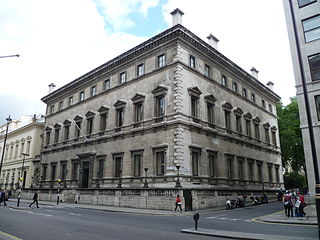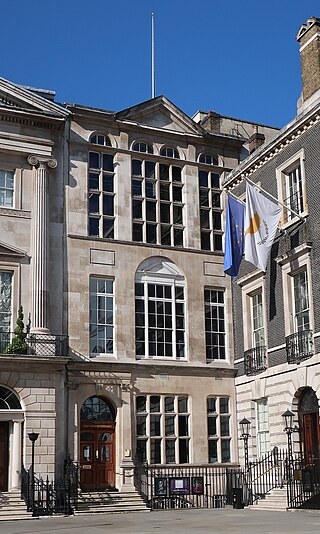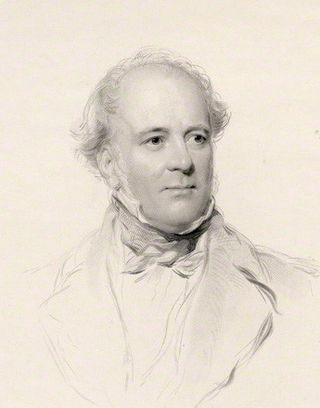Related Research Articles

The Reform Club is a private members' club, owned and controlled by its members, on the south side of Pall Mall in central London, England. As with all of London's original gentlemen's clubs, it had an all-male membership for decades, but it was one of the first all-male clubs to change its rules to include the admission of women on equal terms in 1981. Since its foundation in 1836, the Reform Club has been the traditional home for those committed to progressive political ideas, with its membership initially consisting of Radicals and Whigs. However, it is no longer associated with any particular political party, and it now serves a purely social function.

Sir Roderick Impey Murchison, 1st Baronet, was a Scottish geologist who served as director-general of the British Geological Survey from 1855 until his death in 1871. He is noted for investigating and describing the Silurian, Devonian and Permian systems.

The Worshipful Company of Clockmakers was established under a royal charter granted by King Charles I in 1631. It ranks sixty-first among the livery companies of the City of London, and comes under the jurisdiction of the Privy Council. The company established a library and its museum in 1813, which is the oldest specific collection of clocks and watches worldwide. This is administered by the company's affiliated charity, the Clockmakers' Charity, and is presently housed on the second floor of London's Science Museum. The modern aims of the company and its museum are charitable and educational, in particular to promote and preserve clockmaking and watchmaking, which as of 2019 were added to the HCA Red List of Endangered Crafts.
William John Hamilton was a British geologist who served as a Conservative Member of Parliament.

Edward AdolphusSt. Maur, 12th Duke of Somerset,, styled Lord Seymour until 1855, was a British Whig aristocrat and politician, who served in various cabinet positions in the mid-19th century, including that of First Lord of the Admiralty.

Charles Canning, 1st Earl Canning,, also known as The Viscount Canning and Clemency Canning, was a British statesman and Governor-General of India during the Indian Rebellion of 1857 and the first Viceroy of India after the transfer of power from the East India Company to the Crown of Queen Victoria in 1858 after the rebellion was crushed.

Sir Antonio Genesio Maria Panizzi, better known as Anthony Panizzi, was a naturalised British citizen of Italian birth, and an Italian patriot. He was a librarian, becoming the Principal Librarian of the British Museum from 1856 to 1866.

The London Library is an independent lending library in London, established in 1841. It was founded on the initiative of Thomas Carlyle, who was dissatisfied with some of the policies at the British Museum Library. It is located at 14 St James's Square, in the St James's area of the City of Westminster, which has been its home since 1845. Membership is open to all, on payment of an annual subscription, and life and corporate memberships are also available. As of December 2021 the Library had over 7000 members.

Sir Cyril Fred Fox was an English archaeologist and museum director.

Andrew Rutherfurd, Lord Rutherfurd, was a Scottish advocate, judge and politician.

The Society of Dilettanti is a British society of noblemen and scholars that sponsored the study of ancient Greek and Roman art, and the creation of new work in the style.

Sir Henry Ellis was an English librarian and antiquarian, for a long period principal librarian at the British Museum.

William Collins was an English landscape and genre painter. His sentimental paintings of poor people enjoying nature became a posthumous high fashion, notably in the 1870s when his market price rose higher than Constable and stayed so until 1894. Turner, his model, far exceeded him in value.

William Richard Hamilton, FRS, was a British antiquarian, traveller and diplomat.
The Spalding Gentlemen's Society is a learned society based in Spalding, Lincolnshire, England, concerned with cultural, scientific and antiquarian subjects. It is Britain's oldest such provincial body, founded in 1710 by Maurice Johnson (1688–1755) of Ayscoughfee Hall. Membership is open to anyone aged 18 or over: the term "gentlemen" in the title is historical – there is no discrimination between men and women. Its Grade II listed museum in Broad Street, Spalding, was designed by Joseph Boothroyd Corby and opened in 1911; additions to the building ensued in 1925 and 1960. The carved outside panels were by Jules Tuerlinckx of Malines, a Belgian refugee in the First World War.

George John Warren Venables-Vernon, 5th Baron Vernon, was a British politician. He was one of the last members of parliament for Derbyshire and the first for South Derbyshire. Vernon had a lifetime enthusiasm for Italian literature, particularly Dante after visiting Italy as a child. Vernon county is named after him in Australia.

The British Museum Library: A Short History and Survey is a book by Arundell Esdaile published by George Allen & Unwin, London, in 1946. It was reprinted in 1979 by Greenwood Press, Westport, Conn. from the 1948 ed. published by G. Allen & Unwin, London, which was issued as no. 9 of the Library Association series of library manuals. Esdaile's book serves as a historical survey of the British Museum Library when the museum and library departments were housed in the same building. The book traces the entire history of the institution, from 1753 to 1945.

Louis Alexander Fagan was an Anglo-Italian writer and artist. He worked in the Department of Prints and Drawings for the British Museum from 1869 to 1894, and wrote various books on the department. A painting of his by John Singer Sargent sold at auction for $118,750 in 2020.
Hyde Abbey School was a British independent school in Winchester, Hampshire, UK.
References
- ↑ The Life of Sir Anthony Panizzi, Volume 1, by Louis Alexander Fagan, p256
- 1 2 The Life of Sir Anthony Panizzi, Volume 1, by Louis Alexander Fagan, p257